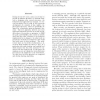364 search results - page 70 / 73 » Modelling Affect in Learning Environments - Motivation and M... |
BMCBI
2008
13 years 9 months ago
2008
Background: Prediction of disulfide bridges from protein sequences is useful for characterizing structural and functional properties of proteins. Several methods based on differen...
FGR
2002
IEEE
14 years 1 months ago
2002
IEEE
We present ongoing work on a project for automatic recognition of spontaneous facial actions. Spontaneous facial expressions differ substantially from posed expressions, similar t...
ATAL
2003
Springer
14 years 2 months ago
2003
Springer
Large systems of agents deployed in a real-world environment face threats to their problem solving performance that are independent of the complexity of the problem or the charact...
AGENTS
1997
Springer
14 years 28 days ago
1997
Springer
During the last few years, and in an attempt to provide an ecient alternative to classical methods to designing robot control structures, the behavior-based approach has emerged....
NIPS
2007
13 years 10 months ago
2007
Recent experimental studies have focused on the specialization of different neural structures for different types of instrumental behavior. Recent theoretical work has provided no...

